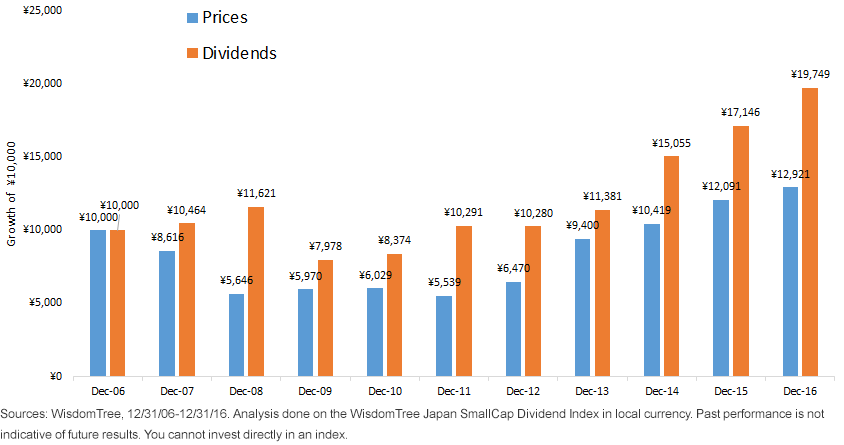
The last decade has not been a great time to be an investor in international stocks, but small-cap stocks internationally outperformed large-cap stocks, and Japanese small-cap stocks (WisdomTree Japan SmallCap Dividend Index) on a dividend-weighted basis actually outperformed the large-cap, market capitalization-weighted index (MSCI Japan Index)” by over 400 basis points (bps) per year over the last decade.
As value-oriented investors, we often believe in the theory of mean reversion, or the tendency for markets to move in cycles but revert to average returns over time. One might think now is the time for Japanese large caps over small caps—given they performed so badly over last decade.
While we believe there absolutely is a case for Japanese large caps—and that ties to the yen and growth in the global economy—below we outline some of the arguments for why Japan is still attractive today, particularly its small caps.
Fundamentals: Market Became Cheaper over Last Decade
Looking at just dividends and prices, one could argue the market actually got less expensive on a price-to-dividend basis over the last decade, as dividends grew faster than prices. Over the last 10 years, dividends grew 97.5%, or 7.04% per year, which is higher than the aggregate price growth of just 29.2%, or 2.60% per year.
WisdomTree Japan SmallCap Dividend Index: Price Growth vs. Dividend Growth
We expect that, with ample cash on their balance sheets and a focus on investor stewardship reforms, Japanese companies will continue to increase both dividends and buybacks over the next few years—a trend very supportive for the markets.
Sources of Future Cash Distributions
There has been a lot of talk about all the cash on U.S. companies’ balance sheets that will be paid as dividends and buybacks with different repatriation policies. Here’s what is interesting in terms of how these cash levels can impact valuations and also the potential for distribution growth: Japanese large-cap companies have three times the relative cash compared to market cap than U.S. large-cap companies (15% cash to market cap versus 5%).

















